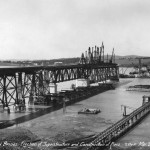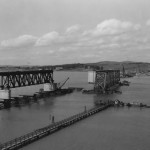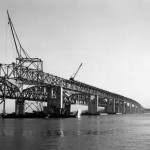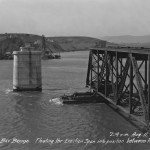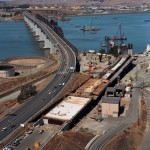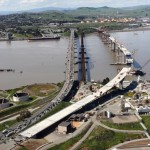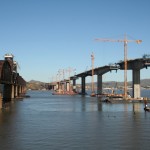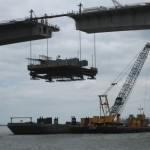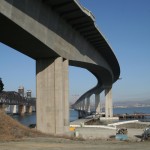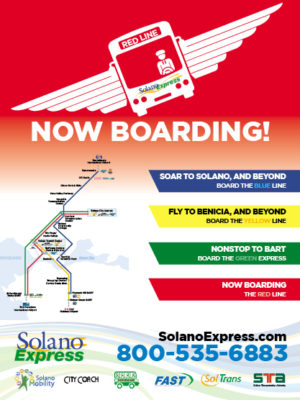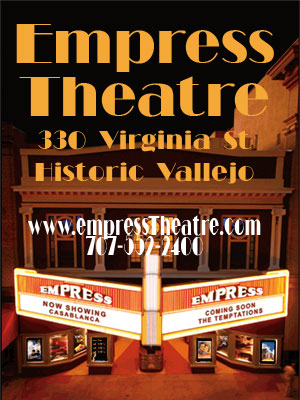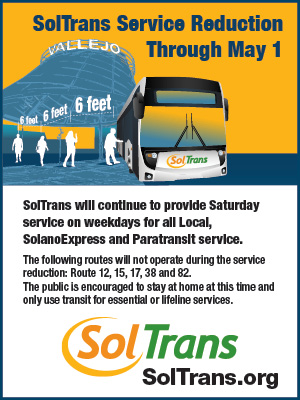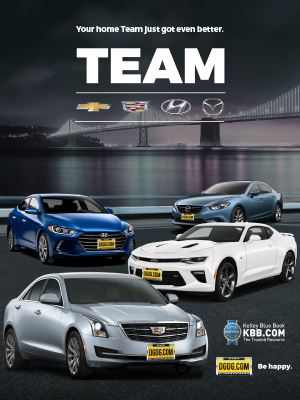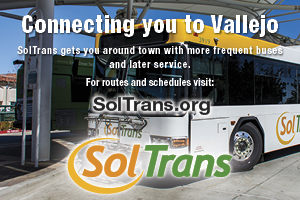Standing on the shoulders of giants
As a Benicia resident for over 15 years and a lover of history, I have taken a strong interest in learning more about my lovely, small city that I am proud to call home. While I have learned a lot about its history over the years, I recently started learning more about the Benicia-Martinez Bridge—which most Benicians simply call the “Benicia Bridge”—but the first thing that everyone should be clear on is that the Benicia-Martinez Bridge actually refers to the three bridges that link Solano and Contra Costa counties together (Benicia and Martinez, respectively) across the Carquinez Strait.
Before I discuss any of the two vehicle bridges, however, I want to give you some history about the oldest of the three bridges: the Union Pacific Railroad Bridge, also called the Benicia-Martinez Rail Drawbridge. Workers started the big cantilever project back in 1928 and finished it in 1930. Workers built this long, 5,620-foot railway bridge using a variety of structural span types—such as trussing, cantilevering, and metal riveting—as a part of the Southern Pacific Railroad (established in 1865). The bridge assisted in not only creating much-needed job opportunities during the wake of the Great Depression, but it also linked the two counties without the need of a train-ferry system.
Before there was a railroad bridge, Benicia had a train ferry called Solano, stationed at the bottom of First Street (the yellow building that is now See’s Candy). Solano would take train cars between Benicia and Port Costa (in service from 1879 to 1930); however, the train bridge’s completion made it much more convenient, as trains no longer had to stop to get on the ferry and experience the whole time-consuming and expensive process of taking the train cars apart.
The Union Pacific Railroad, after merging with the Southern Pacific Railroad in 1996, now owns the Benicia-Martinez Railroad Bridge. Its railway remains as the only train bridge to have tracks cross the bay in California. It is also the second-longest railway on the continent and holds the record for the longest railway bridge west of the Mississippi River.
Today, long freight trains and Amtrak trains frequent the Union Pacific Railroad Bridge (passenger trains include the short-haul Capitol Corridor trains and long-distance trains California Zephyr and Coast Starlight). While Amtrak does not stop in Benicia—something I have always wondered—it passes through, and folks can get an amazing view of the Strait when crossing the bridge this way. Taking a ride on Amtrak is really worth it for this experience alone (I used to really look forward to it while traveling to and from Davis as an undergraduate at UC Davis). Locals can hop on Amtrak at one of its nearby stations, namely in Martinez or Suisun.
Most know that the train bridge is in the middle of two vehicle bridges that are a part of I-680. The original vehicle bridge (now the I-680 southbound bridge) was built in 1962, formerly named the George Miller Jr. Bridge, and it was not until years later when the new bridge opened in 2007 (the I-680 northbound bridge, formerly named Congressman George Miller Benicia–Martinez Bridge).
Because, I didn’t know much about the new vehicle bridge’s construction, our very own Robert Briseño (one of the founders of Local Happenings Magazine) pointed me to John V. Robinson, an established author and teacher who wrote the book Building the Benicia-Martinez Bridge (2007), which closely shows his documented construction of the new Benicia-Martinez Bridge (the I-680 northbound bridge) through great images and insights. In addition to Robinson’s book about the new Benicia-Martinez Bridge, he has written a book on the Carquinez Bridge and the Alfred Zampa Memorial Bridge, and was even lucky enough to have met and interviewed the legendary bridge-builder, Alfred Zampa, in 1995.
I asked Robinson about the new Benicia vehicle bridge, starting with if he knows why it was constructed with cantilevering underneath the bridge, as opposed to being above it. “The construction of the new Benicia Bridge was very different from the Zampa Bridge or the New Bay Bridge,” he said. “Why Caltrans chose the cast-in-place cantilever design is a good question that I have never heard a good answer for. A suspension bridge, like the Golden Gate or the Zampa Bridge, would have been faster and cheaper, so … who knows what they were thinking?”
Wanting to know more, as one writer to another, I asked Robinson what inspired him to write the book. “Proximity and luck,” he expressed. “They built a bridge here in Crockett, so I started photographing it. Then I met some guys from the Benicia Bridge project and they invited me to photograph that bridge, too. This is in 2003, early on in the construction. After I made my first book, the contractor at Benicia wanted the same for that bridge, so I started researching the bridges around here and produced that book.”
I also asked about Robinson’s views about the new bridge. “The new bridge was expensive and took a long time to complete,” Robinson said, “but the sleek design makes driving across it seem like flying.” If you drive on the new bridge, then you will surely know the feeling.
The California Transportation Journal (2008) elaborates, “The new Interstate 680 crossing of the Carquinez Strait between Contra Costa and Solano counties has numerous advancements over the 1962 version. The incredible complexity of the $1 billion project is hidden in the bridge’s sleek elegance.” The bridge’s sleek road provides a smoother ride with the added benefit of better gas mileage that commuters can especially appreciate. Also, the new bridge has five lanes, all going in one direction—immensely helping traffic flow, while the original vehicle bridge (now I-680 southbound) used to have two-way traffic.
Aside from the $5 bridge toll that remains — which folks can automatically pay with FasTrak to avoid toll lines — the vehicle bridges are great, especially with their new, much-needed 2007 additions that replaced their 1962 predecessors.
One of my favorite additions is the Benicia-Martinez Bridge Vista Point, a little park for picnicking and sightseeing. Vista Point can be easy to miss for newcomers; it’s slightly hidden on hilly terrain within the I-680/I-780 intersection complex on the Benicia side of the Strait (look for the freeway sign). Because of its scenic views of the Benicia-Martinez Bridge, Carquinez Strait, Mothball Fleet (aka the Suisun Bay Reserve Fleet), Mount Diablo, and so forth—Vista Point is definitely worth bringing the family or a date to. Of course, a camera and binoculars are recommended.
However, the best addition, in my opinion, is the pedestrian and bike road—safely fenced to the right of the southbound vehicle bridge—that is accessible off of Park Road in Benicia or Mococo Road in Martinez, though be very careful on Mococo Road because of fast cars, trucks, trains (i.e., bring a friend). I highly recommend experiencing the Benicia-Martinez Bridge outside of a car at least once—which can be included in a long run or bike ride—to really notice the beautiful, panoramic view of Benicia, the Carquinez Bridge, Alfred Memorial Bridge, and the Strait while hearing the soothing train horns that reverberate on the water. As a challenge, try to see if you can spot Port Costa, indicated by the rooftops that are tucked in the green rolling hills that outline Martinez.
To learn more, read John V. Robinson’s Building the Benicia-Martinez Bridge (2007).
Enjoy a ride on Amtrak. Get tickets at amtrak.com.
You can also visit the Caltrans website at dot.ca.gov.
By James Quinn
James Quinn lives in Benicia and teaches at Elmer Cave Language Academy in Vallejo. A UC Davis alumnus in English, he now studies education as part of Touro University’s Master’s in Education program. Along with teaching, he tutors and writes often. He is working on a novel that takes place in Benicia. See his website at mrquinnj.weebly.com.


